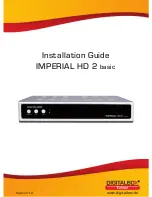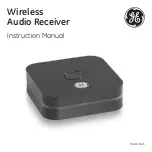
How does Logic 7 work?
Logic 7 processes analog or digital sources in the digital domain, producing a multichannel mix. First developed
in an era when even the most advanced digital surround processors recognized only5.1 output channels, and
conventional analog decoders had only four outputs (front left, front right, center and a mono signal sent to rear left
and right), Logic 7 conceptualized discrete rear channels, and two additional side channels between the front and
rear. The additional outputs in the processing algorithm enable Logic 7 to more precisely steer sounds to the rear
channels. The benefits are clear:
■
Logic 7 is able to re-create the “.1” low-frequency effects channel.
■
With its separately programmed Music mode, older two-channel recordings can be played with
an improved wider soundstage, more closely preserving the benefits of two-channel playback,
while reproducing the ambience and envelopment inherent in the two-channel recording, which
creates the realistic effect of being present at a live performance.
■
In Cinema mode, Logic 7 enhances the intelligibility of center channel dialogue.
■
Even when only 5.1 channels are in use, the conceptual presence of the additional side channels
improves pans and flyovers.
■
Since the five channels outputted by Logic 7 are discrete, Logic 7 can re-create pans not only from
front to rear and side to side, but diagonally.
How can consumers benefit from Logic 7, a technology
that was developed for use by the professional
recording industry?
Logic 7 was originally developed and introduced by Lexicon, Harman Kardon’s sister company. Logic 7 is a
proprietary technology; therefore, it can be found only in Harman International products.
Harman Kardon incorporates Logic 7 decoding in all of its audio/video receivers, including models AVR 125,
AVR 225, AVR 325, AVR 525, AVR 7200, DPR 1001 and DPR 2001.
Models with 7.1 channels (AVR 325, AVR 525, AVR 7200, DPR 1001 and DPR 2001) offer a choice
of the 5.1 or 7.1 versions of Logic 7, depending on the number of speakers the user has actually connected
to his or her system. An even more exciting development is the adaptation of Logic 7 for 96kHz processing,
preserving the high resolution and astonishing sound quality of the latest audiophile recordings.
Logic 7 Cinema mode is designed for use with matrix-encoded (e.g., Dolby Surround) sources, including video
cassettes, television broadcasts, cable and satellite programs, and many DVDs. Compared to other matrix decoders,
Logic 7 provides improved center channel intelligibility, a wider soundstage, improved steering and pans, and
dynamic low-frequency effects.
Logic 7 Music mode is designed especially for use with two-channel audio sources, and is optimized for accurate
reproduction of lead and background vocals and instrumentals. These sources include most CDs, concerts, FM radio
broadcasts and older two-channel sources. Logic 7 produces a wider soundstage and improved rear ambience,
as well as a low-frequency effects channel, re-creating the best of the original two-channel recording while adding
new realism.
Whether you’re enjoying music or movies, your favorite TV show, a CD or a video, Harman Kardon and Logic 7
processing will deliver superior surround sound from any source.
For an interactive demonstration of Logic 7, and to
learn more about Harman Kardon’s advanced home theater
products, visit www.harmankardon.com.
Harman Kardon, Power for the Digital Revolution and Logic 7 are registered trademarks of Harman International Industries, Incorporated.
*Trademarks of Dolby Laboratories. Part No.: LOGIC7TS
hkh1216.logic7.tech.sheet.qxd 4/24/03 12:55 PM Page 2




















